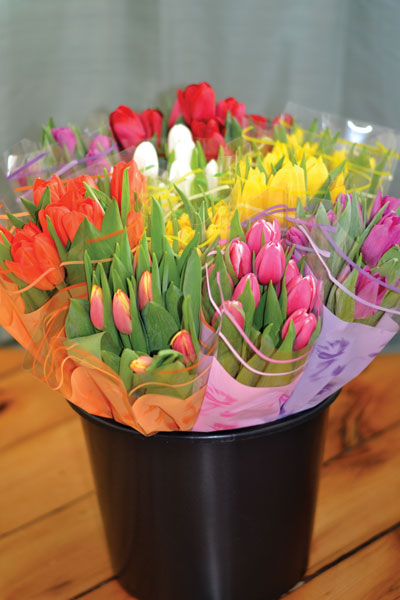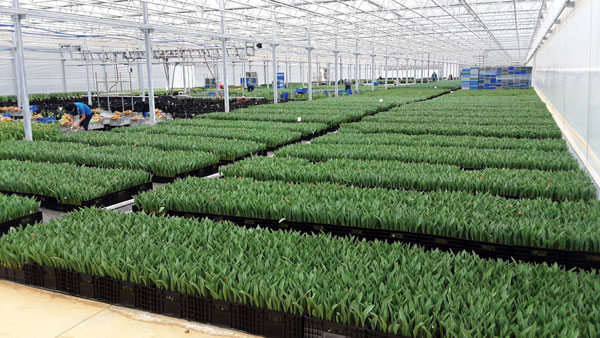4/1/2019
Everything is Coming Up Tulips
Anne-Marie Hardie

Now in its third generation, Holland Greenhouses in Monroe Township, New Jersey, has become much more than a wholesaler of tulips; this company has become a true advocate for sharing their love of this diverse bulb throughout the United States.
The journey for Holland Greenhouses began in 1964 when Casey Jansen, Sr. emigrated from Holland to work as a Dutch bulb salesman.
“His father, my great-grandfather, worked on a tulip farm,” said Casey Jansen, Jr. Tulips were a part of his past and it was this beautiful plant that would shape his family’s future.
Pictured: Casey Jansen, Jr.—who is now the third generation to run Holland Greenhouses—has a goal of supplying a bouquet of tulips to every home in America.
The tulip industry in North America was in its infancy. It didn’t take long for Casey Sr. to identify that there was an opportunity to expand the industry into other segments—specifically, potted plants. Within five years, he had purchased his first greenhouse in Monroe Township. It was here that Casey Sr. began to develop a niche in bulb potted plants, which were then sold to local retailers, mainly grocery stores and garden centers.
Over the years, he became one of the leaders in the industry providing finished plants, including daffodils, hyacinths, and of course, tulips to both garden centers and grocery retailers.
“At one time he was servicing all of the big box stores in the East Coast,” said Casey Jr. It was a seasonal business that peaked at Easter. For several decades, the business continued to thrive. However, in the ’90s, the demand for potted bulb plants was shifting and the Jansen family knew it was time to evolve the business once again.
“When I entered the business in 1995, we had begun to see a change in the industry, and so we made the decision to slowly transition from potted bulbs to cut flowers,” said Casey Jr.
During that initial transition year, Holland Greenhouses planted a couple of million stems of tulips that they would use for the cut flower portion of their operation. However, the process from planting to cut flower was extremely time consuming and costly.
“It took 16 weeks to root the bulbs, and then they needed to be picked and cleaned, “said Casey Jr.
The company knew if they wanted to continue with cut flowers then they’d have to find a more efficient method to grow and harvest the plants, so the father-and-son team began to look at hydroponic systems and its potential for the tulip industry.
“The hydroponic business in Europe was thriving,” said Casey Jr. “And so we immediately wondered how we could adopt this method to advance our cut flower operation.”
Initially, Holland Greenhouse was cautious in their approach, converting only 5% of their operation to the water method. But the difference between the two production methods (rooted and hydroponic) was so dramatic that they made the decision to fully convert their operation.
“The bulbs rooted in three weeks vs. 16 weeks in the rooted method,” said Casey Jr. “And the cleanliness of the facility was extremely conducive to our budding cut flower operation.” By the third year, the company shifted their entire operation to hydroponics.
 Over the last decade, Holland Greenhouses has continued to automate and evolve their operation. Interest in tulips is continuing to expand throughout the United States, and more specifically, interest in domestically grown tulips.
Over the last decade, Holland Greenhouses has continued to automate and evolve their operation. Interest in tulips is continuing to expand throughout the United States, and more specifically, interest in domestically grown tulips.
“Even today, we are still expanding,” said Casey Jr. “We offer a high-quality, sustainable, domestically grown U.S. tulip.”
Pictured: Holland Greenhouses in Monroe Township, New Jersey, has grown tulips since the 1960s and now grows this bulb crop hydroponically.
The hydroponic system is housed in a traditional glass greenhouse providing the tulips with the added benefit of natural lighting.
“The reduction in the overall carbon footprint with hydroponics can’t be ignored,” said Casey Jr. “We used to have to use a couple of coolers for the rooted tulips; now we only use a third of that space.”
When asked about starting a growing operation, Casey Jr. emphasized the importance of being receptive to change.
“Don’t get stuck in a mousetrap and continue doing the same thing just because that was the way it was done before,” he said.
For Holland Greenhouses, this includes not only looking at innovative ways to automate their business, but also to find ways to educate and engage the American consumer about locally grown tulips.
“The interest in tulips has come a long way; it’s become the new rose,” said Casey Jr. “There is just so much variety with tulips—different colors, sizes, shades, variegated leaves, two tones. You don’t have that with roses.”
Most recently, Holland Greenhouses opened a sister company, Holland Ridge Farms, to focus on the “agri-tainment” side of the tulip industry. This included developing a large display field, like the ones that can be found throughout Holland, to showcase the diversity of this plant. Last year, Holland Ridge Farms hosted their first annual tulip festival, which was timed during the blooming period of this large field.
In addition to astounding onlookers with the sheer wonder of millions of tulips blooming, the company converted an old barn into an on-site tulip museum to showcase the development of the industry over the ages. Visitors were also entertained by a short video in the Holland Wood Theatre, which introduced the public to the evolution of the tulip, from the harvest techniques in the past to modern times.
To promote the event, the company launched a large ad campaign drawing people across the region to the tulip-centric event.
“We had such a great turnout; the cars were bumper to bumper,” said Casey Jr. This year, the company has tripled the size of the display gardens with the goal to continue to educate and showcase to the public the possibilities of this plant.
When asked about his goals for the future, Casey Jr. shared that he would like to continue to educate the public about the possibilities of the tulip. His dream is to be able to work together with other domestic growers to supply a beautiful, locally grown, bouquet of cut tulips to every home in America. GT
Anne-Marie Hardie is a freelance writer/speaker from Barrie, Ontario, and part of the third generation of the family-owned garden center/wholesale business Bradford Greenhouses in Barrie/Bradford, Ontario.